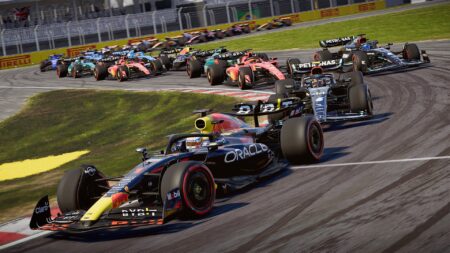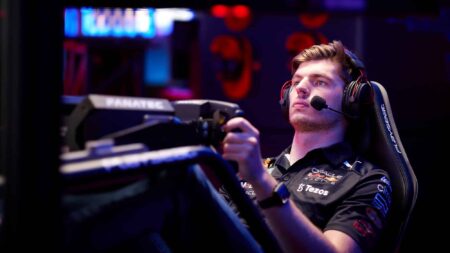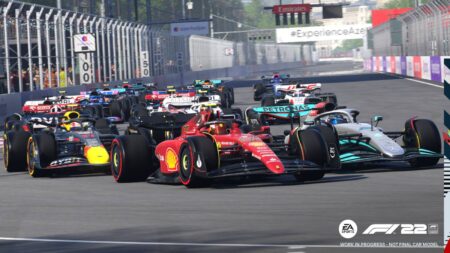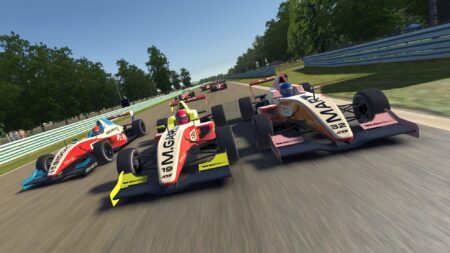
F1 23 review: racing rejuvenated or relapsed?
Our detailed review of the new F1 23 game including new features, new circuits and a brand new story mode
‘The most beautiful, intense, authentic and technically-advanced racing game on the planet.’ It’s a bold claim, so a trip to the Bandai Namco studios was in order to see if the game stacks up
There’s been a lot of hype surrounding the second iteration of Project Cars, set for release on September 22. It’s being billed as the most advanced racing game ever, with unprecedented realism, dynamically evolving conditions and an enviable roster of licensed cars and circuits. That’s saying something in a market of already very high standards.
In terms of sheer variety, Project Cars 2 looks tough to beat. With a line-up of more than 180 cars, ranging from fire-spitting rallycross supercars to classic endurance prototypes, this may be the only game where you can transition seamlessly from a Silk Cut Jaguar to a Hoonigan Focus RS. There’s no shortage of playgrounds either, with more tracks than in any other console game: Le Mans, Nordschleife, Brands Hatch, Oulton Park – all the classics you’d expect in a top-line game are included. Fancy taking a Lotus Type 78 for a lap around Spa in the snow? Or the Indy 500 or the Le Mans 24 Hours (in real time, of course) in the exact conditions the competitors faced in 1994? The game developers have you covered.
The team at Bandai Namco was keen to showcase just how far the game has come from the original with regards to driving with a controller, so that’s what I was given the opportunity to test. Three cars at three tracks covering three disciplines were loaded to the PC and an evening of immersion was about to fly by.
To get off the mark, a Ferrari 488 at Portimão Circuit, with two laps to get a feel for the car and the controls. The ultra-realistic cockpit and manual rolling start is fantastic – it’s simple-but-rare things like a manual start that make a race fan like myself far too excited. I modulate the throttle to hold my position behind the Audi in front, five red lights, then green and as I floor the throttle the thunder of an Italian V8 reverberates. The sound is phenomenal and I can’t resist switching to the external camera shot that gives the Ferrari even more raucous growl. Racing in a pack at full tilt is evocative and the sound is certainly a match for the graphics, which are second to none. It is ridiculously realistic, and I can only imagine how this game would play in VR with the in-helmet camera view.
Into Turn 1 I hit the brakes hard and rub through on the inside of a Mercedes, feeling the bump of the high apex curb. Overtake complete? Not in this game. The Mercedes holds its own around the outside and gets stuck into the battle ahead, giving me the sinking feeling that I’ve been comprehensively outdone by a computer. While the artificial intelligence [AI] is not defensive into corners, something that has disappointed in countless racing games, it is aggressive and appropriately so. It makes the reward all the sweeter when you pull off a clean pass after a side-by-side battle and it’s so pleasing to race against an AI that is willing to put a wheel on the grass and engage in proper cut-and-thrust racing.
“One lap to go, keep pushing,” says a muffled voice over the team radio, which barely audible over the V8. In my two lap race, the team radio was a little too ‘arcade game’, but over a longer race it would play a more important role. After all, this is a game where you can run a real-time 24-hour race.
Last lap and this race has been set on an ultra-fast day-to-night transition, because the setting sun is now blinding and casting awesome patterns across the race track. Headlights switch on and the game takes on yet another immersive dimension, although this is just scratching the surface of the game’s potential. The game features four seasons, including snow and dynamic transitioning weather, making it a huge step up in realism from the original. Water pools on the surface, changing the effect on the tyres and making the circuit evolve over a race weekend. Rubber marbles gather late in top-class ‘Formula A’ races and the game’s developers even went to the lengths of talking to meteorologists to ensure they got the dynamic of the changing weather as realistic as is feasibly possible.
Just a few corners to go and I’m closing down the BMW ahead. As I near, I begin to recognise the livery – it’s unmistakably Falken. It’s great to see real-world liveries and drivers in the game and all the cars you may have hoped to have raced in the original game are now included, such as Porsche and Ferrari. Three corners left, what’s to lose? I launch down the inside of the BMW but completely misjudge my corner entry speed and spin into the gravel trap. I’m strangely delighted to find that it’s a real struggle to crawl out of the gravel trap, but a racing sim should punish you for your mistakes and so many games don’t. This is a big plus.
Next it’s rallycross, something that should test out the game’s performance with the controller. The circuit is Lohéac in France, the view is from the low cockpit of a Honda Civic. On the narrow starting grid, the game again scores full marks for realism. Flooring the throttle, 600bhp fires out the rear – if the Ferrari sounded good, this is something else. The start is bunched but when the track opens up and the car is able to run the control is surprisingly pleasing. The car is eager to slide and easy to control with some opposite lock, and modulating the throttle makes it pretty easy to keep it smooth through the corners with a controlled drift. I’m no veteran of playing racing games with controllers, but this feels excellent.
“Right hand side,” says the spotter, and this team radio is useful. The mirrors are superb and it’s possible to see clearly who’s coming, but it’s useful to have a second pair of eyes on your side. Then, bang: my Civic is turned around into the right-hander and forced into the joker lap – at least I’ve discovered where it is. Re-joining in the middle of the pack, again the aggressiveness of the AI seems very well set. It was frustrating in the Ferrari to be told constantly to give positions back for driving standards, but a bit of rubbing goes in the rallycross.
The realism of the game comes from the input of real-world drivers and teams, according to Namco’s marketing manager Phil Brannelly. “We’ve had Nicholas Hamilton, he’s a big online racing nut, and Ben Collins too – the original Stig,” he says. “I think they’re a bunch of loons down at Slightly Mad Studios [the game developers] in terms of the detail they go into. A lot of the racing teams are pretty surprised by how much detail goes into it when they approach and say ‘we’d like to put your car in the game.’ The teams have shared a lot of the physics from their cars, which really adds to the level of detail.”
A growing e-sports scene and high-profile drivers such as Max Verstappen training on computer games has helped drive the industry forward. Online racing championships feature prominently in-game. “E-sports is really big on Slightly Mad Studio’s agenda now and it presents a real opportunity for a racing car game,” Brannelly explains. “I’ve been in the industry a long time and I can remember racing drivers using Geoff Crammond Grand Prix to learn the track back then. The game graphically is so real now, especially with VR.”
There’s clearly more to come, but the brief taster shows already that Project Cars 2 will be hard to beat. Driving feel with the controller impressed, although to call the physics groundbreaking may be stretching it. The realism is, however, and there’s a sense of immersion that many racing games could only dream of achieving. The AI is very well balanced and the whole experience will be enhanced no end by the dynamic weather and seasons in the final release.
One games reviewer said this is the best racing game of the year, and that’s quite an accolade. Certainly, whether you’re an arcade racer or a pro-sim e-sports competitor, there are some very long evenings of gameplay ahead.

Our detailed review of the new F1 23 game including new features, new circuits and a brand new story mode

Max Verstappen quit the 2023 Virtual Le Mans 24 Hours and labelled it a "clown show" after connection issues, but many say that technical issues are simply part of sim racing

A new era of F1 cars, complete challenges in supercars and VR compatible are key features for this year's game and more

Esports has long been viewed as insignificant but 'old views' need to change according to some drivers